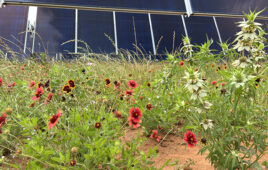When a company has been involved in construction for over a century, its work has moved miles and affected the American landscape in a way few contractors can claim. With that level of involvement in the field, defaulting to minimal consideration for restoration on construction sites might be the quick solution, but McCarthy Building Cos. (No. 21 on the 2020 Top Solar Contractors list) makes sure its solar installers are taking extra care of the environments where its arrays are built.

McCarthy replants native vegetation on its solar sites.
The 156-year-old heavy-build construction company entered the solar market in 2013 and has installed 2 GW of solar PV since. About three years ago the company started implementing site restoration and stormwater pollution prevention plans (SWPPP) to minimize solar project impacts on local waterways and surrounding environments.
“Solar construction has a lot of differences than your typical construction. Normally, you’re on a postage stamp, building in an urban area, and runoff…you’re worried about it, but you’re only trying to control it within two to five acres,” said Scott Canada, VP of McCarthy’s Renewable Energy & Storage group. “Here, we have several hundred, and we actually have to train our operational staff in how to be really good at understanding when they have a problem, having a regular check-in with the civil engineers and the vegetation experts and [agricultural] experts every two weeks or so.”
McCarthy has a board of consultants that will direct project runners to experts on agriculture, reclamation and conservation in the areas where they’re working. As Canada put it, these practices are taking old knowledge and technology and applying it to a new problem. His team uses the U.S. Geological Survey, a federal department dating back to the late 1800s, as a resource for data on agricultural land, rainfall and how well certain soil types drain water.
“We all looked at each other and said, ‘How could we have been in this industry for years and not known that this exists?’” Canada said. “There’s all this drain tile, detention and all these technologies that have been around for tens of years, if not hundreds of years, for managing water on a site and helping crops grow. It’s reaching out to find these old approaches and applying them to a whole new industry, and, sure, it’s not the flashy technology, but it’s incredibly effective.”
Stormwater pollution prevention became a more prevalent issue once McCarthy solar installers expanded out of drier climates and into those with heavy rainfall. Unlike installing or assembling certain solar equipment, every construction site requires a different approach for a proper reclamation and an SWPPP.

Including proper stormwater drainage at solar construction sites prevents accelerated erosion that could affect local waterways.
Replanting or replacing pollinator-friendly and native vegetation and adding retention sites can limit erosion that would occur from rainfall if the construction site was left as-is. McCarthy has also introduced livestock like sheep to solar sites for vegetation management. The company is careful with these decisions, and in one case planted vegetation a year before construction on an array in Georgia to protect its native wetlands.
McCarthy transfers ownership of its arrays to another party when construction is complete. Given the longevity of solar, considerations like these are necessary not only ecologically, but for the people in these communities where the solar systems will reside, Canada said.
“We’re not like a coal plant belching out pollutants. If we don’t do what’s right for the land and do what’s right for the folks next to us and figure out how to be innovative with livestock, pollinating grasses and vegetation, and bees, then we’re missing a real opportunity and may hurt our future,” he said.
This story was featured exclusively in our 2020 Top Solar Contractors issue. See the issue and full list of top U.S. solar installers here.





Tell Us What You Think!